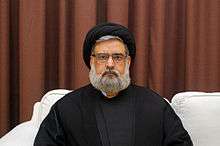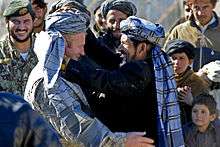Turban
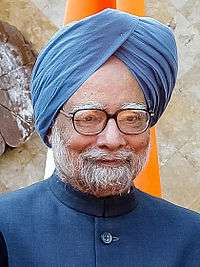
A turban (from Persian دولبند, dulband; via Middle French turbant) is a type of headwear based on cloth winding. Featuring many variations, it is worn as customary headwear primarily by men.[1] Communities with prominent turban-wearing traditions can be found in the Indian Subcontinent, Afghanistan, South Asia, the Arabian Peninsula, the Middle East, the Near East, Central Asia, North Africa, the Horn of Africa, the Sahel, and parts of the Swahili Coast.
Wearing turbans is common among Sikhs, including women,[2] who refer to it as a Dastar. In certain other faith communities, the headgear also serves as a religious observance, including among Shia Muslims, who regard turban-wearing as Sunnah Mu'akkadah (confirmed tradition).[3] Greeks, in ancient times, wore a distinctive style of turbans.[4]
Additionally, turbans have often been worn by nobility, regardless of religious background. They are also sometimes donned to protect hair or as a headwrap for women following cancer treatments.[5]
History
The origins of turbans are uncertain. Early Persians in modern Iran and Phrygians in modern Turkey wore a conical cap (Phrygian cap) encircled by bands of cloth, which historians have suggested was developed to become the modern turban, but other theories suggest it was first widely worn in Egypt. An early attestation for knowledge of the turban is found in the Roman author Ovid's Metamorphoses, dating to the 1st century BC. Ovid recounts the myth that Midas king of the Phrygians, an Indo-European people of central Turkey, wore a royal purple turban to cover his donkey ears.[6][7] A style of turban called a phakeolis continued to be worn in that region by soldiers of the Byzantine army in the period 400–600,[8] as well as by Byzantine civilians as depicted in Greek frescoes from the 10th century in the province of Cappadocia in modern Turkey,[9] where it was still worn by their Greek-speaking descendants in the early 20th century. The Islamic prophet, Muhammad, who lived 570–632, is believed to have worn a turban in white, the most holy colour. Many Muslim men choose to wear green, because it represents paradise, especially among followers of Sufism. In parts of North Africa, where blue is common, the shade of a turban can signify the tribe of the wearer.[10]
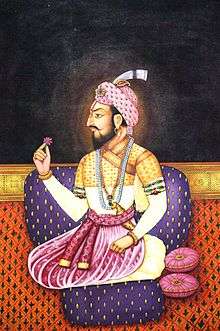 The Maratha Chattrapati Sambhaji, wearing a Turban, jeweled with gemstones.
The Maratha Chattrapati Sambhaji, wearing a Turban, jeweled with gemstones.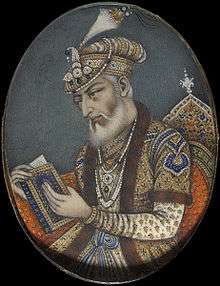 The Mughal Emperor Aurangzeb wearing a Turban and its ornaments.
The Mughal Emperor Aurangzeb wearing a Turban and its ornaments. Sultan Mehmed II wearing a Turban.
Sultan Mehmed II wearing a Turban.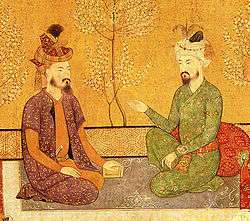
 Suleiman I wearing a large Turban.
Suleiman I wearing a large Turban. Selim II wearing the Ottoman imperial Turban.
Selim II wearing the Ottoman imperial Turban.
National styles

Contemporary turbans come in many shapes, sizes and colours. Turban wearers in North Africa, the Horn of Africa, the Middle East, Central Asia, South Asia (including Sikh), and Philippines (Sulu) usually wind it anew for each wearing, using long strips of cloth. The cloth is usually under five meters in length. Some elaborate South Asian turbans may also be permanently formed and sewn to a foundation. Turbans can be very large or quite modest depending upon region, culture, and religion.
Traditionally, turban has been the name of a type of headwear worn by women in Western countries. The wearing of such turbans by women in Western societies is less common than it was earlier in the 20th century. They are usually sewn to a foundation, so that they can be donned or removed easily.
Horn of Africa
Turbans are commonly worn in the Horn of Africa by Muslim clerics, as well as Ethiopian Orthodox Christian priests. The headwrap has a long presence in the region, where it was frequently sported by Sultans, Wazirs, and other artistocratic and court officials. Among these nobles are the Somali Sultans Mohamoud Ali Shire of the Warsangali Sultanate, Osman Mahamuud of the Majeerteen Sultanate, and Yusuf Ali Kenadid and Ali Yusuf Kenadid of the Sultanate of Hobyo. Prominent historical Islamic leaders in the region that are known to have worn turbans include Sheikh Abadir Umar Ar-Rida.
Arabian Peninsula
In most countries of the Arabian peninsula, a plain or checkered scarf (called keffiyeh, ghutrah, shumagh or ghabanah), not usually described as a turban is often worn, though the Arabic Emamah tradition remains strong in Oman (see Sultan Qaboos of Oman), Sudan and some parts of the Arabian peninsula. The colored turban, Ghabanah, is a common inherited cultural turban in the regions of Hijaz, and it still the inhabitants costume of Mecca, Madinah and Jeddah in particular. Ghabanah is the heritage uniforms for traders and the general community categories of the prestigious and middle-class, with the exception of religious scholars who have had their special turbans distinctiveness predominately white. The Hijazi turbans with different shapes are the extension of the turban of Islamic prophet Muhammad who lived in Mecca and Madinah. There are several types of Ghabanah, perhaps the most famous is the yellow (Halabi), that made in Aleppo, that characterized by different inscriptions, and wrapped on a dome-like hollow taqiyah somewhat. colorful turbans are the national costume in Oman, and also are common in some regions in south of Yemen and Hadhramaut. Moreover, the white ghutrah or shumagh are commonly wrapped in Hamdaniyah style, which is the shape of turbans in the United Arab Emirates.
Afghanistan
Turbans are part of the national dress in Afghanistan. They are used more widely here than elsewhere in the Muslim world, and are worn in a wide range of styles and colours. In the country's south-east, turbans are wrapped loosely and largely, whereas in Kabul the garment tends to be smaller and tighter. In traditional Afghan society, a related piece of extra cloth called a patu serves practical purposes, such as for wrapping oneself against the cold, to sit on, to tie up an animal or to carry water in the cap. Different ethnic groups in Afghanistan wear different lungees with different patterns, way of styling it, fabric, stripes, lengths and colouration. Some styles are, however, nationwide. The styles extend and overlap into western Pakistan.
Myanmar
In Myanmar, the turban is referred to as a gaung baung. There are several regional styles worn.
India
_(8411728143).jpg)
In India, the turban is referred to as a pagri, meaning the headdress that is worn by men and is manually tied. There are several styles, which are specific to the wearer's region or religion, and they vary in shape, size and colour. For example, the Mysore Peta, the Marathi pheta, Puneri Pagadi and the Sikh Dastar (see below). The pagri is a symbol of honour and respect everywhere it is worn. It is a common practice to honour important guests by offering them one to wear.
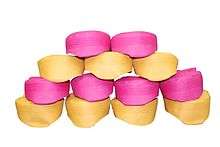
Colours are often chosen to suit the occasion or circumstance: for example saffron, associated with valour or sacrifice (martyrdom), is worn during rallies; white, associated with peace, is worn by elders; and pink, associated with spring, is worn during that season or for marriage ceremonies.
Navy blue is a color common more to the Sikh Nihangs, it signifies war and service, while black is associated with resistance, orange with martyrdom and white with old age, death, or peace; however during times of peace or rallies for peace people will usually be in war gear (i.e. blue) white only has the association.
Indonesia
In Java, the turban-styled headdress for men is traditionally called iket. It literally means to tie, the main way to attach the fabric over the head of the wearer. It is made of a square or rectangular batik cloth that is folded diagonally to form a triangle. Although there are different ways of folding and tying the fabric over the head, and therefore different shapes of iket, they can in general show the social level of the wearer and the area of origin. Its origin is not yet clearly identified, however many sources seemed to conclude that the Javanese might be influenced by turban-wearing Gujarati traders who came to Indonesia more than 500 years ago.
In East Java, the headdress is still made in traditional way and it is called udeng. In other parts of Java, for practicality the iket has developed into fixed-form headdresses, called blangkon in Central Java and bendo in West Java. The batik cloth is made stiff through a process of molding, attaching to stiff paper, and sewing. Similar to iket, blangkon and bendo come with some variations of shapes based on the areas of origin and the wearer's social rank.
Pakistan
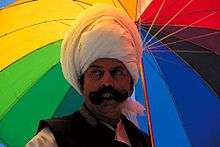
In Pakistan, the turban is in widespread use, especially among the rural population. It is worn in different styles and colours across the country, varying by region, e.g. in the north of the country, black and white turbans are preferred. The turban most commonly found in Pakistan is white and crestless, and worn commonly in the Pashtun belt, while in rural Punjab and Sindh, it is mostly worn by elders or in rural areas. The turban is called either a Pagri or Pag, while it's called Lungee by Pashtuns.
United Kingdom
.jpg)
In the United Kingdom, turbans have been worn by men and women since the sixth century without ever becoming very common. Poet Alexander Pope is sometimes depicted wearing a turban, as were other notable men seen in contemporary paintings and illustrations. The common use of turbans on less formal occasions, among gentlemen at the time, reflects that their heads were closely cropped, or shaved, to allow the wearing of the elaborate wigs that were the fashion in Europe in the century from about 1650 to 1750, and when wigs were off, some kind of head cover was useful. Hence, the turban.
Now that hats are infrequently worn, turbans too are relatively uncommon. They are worn primarily by women of West Indian descent, Karinas. Some women wear them to make a statement of individuality, such as the British social entrepreneur Camila Batmanghelidjh, who usually wears a colourful matching turban and robe.
Greece
In Greece, specifically the island of Crete, the men traditionally wear a turban known as a sariki. The headwrap's name is borrowed from sarık, the Turkish word for turban. Today, it may be more commonly known as a kritiko mandili (Cretan kerchief). It is not found commonly amongst the younger generation, but mostly worn by older men in remoter, mountainous villages. It is traditionally black, the color of mourning, but can also be found in white, for festive occasions such as weddings. It is very commonly found as a part of the standard Cretan costume worn by members of Greek dance groups. A similar head garment is also worn in various parts of Cyprus, and can be seen in various Cypriot shows depicting traditional Cypriot society, e.g. the comedy Aigia Fuxia.
Fiji
Fijian chiefs and priests were known to have worn masi (barkcloth) coverings around their head similar to a turban, called an i-sala. However, most of the bulk and shape of the i-sala came from the bushy hair under the cloth.[11][12]
Babuyan Islands
On some Babuyan islands (Philippines) the head of the household wears a white turban, the younger males wear a red turban after their 13th birthday. The 3 chiefs all wear yellow turbans. It no longer has religious significance and the origin dates back to the end of the Tondo era (cira 900s - 1589) Most Babuyan settlers fled the Philippines in 1589 when Spain began to invade the Philippines. The turban was made from a type of bark cloth but now is made from cotton or silk brought over from the Philippines mainland. The turban style head dress is then cut and wrapped around the head, then tucked in front.
Armenia
While it is true that Armenia is the first Christian country, much of its traditions and cultures reflect Middle Eastern origins. Because of that, men sometimes wear turbans, often bearded on any occasions, but they are usually worn for celebrations and festivals as part of their national costumes. However, before Armenia became a Christian nation, its people actually do used to wear turbans as their daily clothing, just like all other Middle Eastern countries do.
Other

On the Swahili Coast, turbans were frequently worn by the ruling Omani Sultans of Zanzibar and their retinue.
Tuareg Berbers, and some northern Berbers, Sahrawi, Songhai, Wodaabe, Fulani, and Hausa peoples of North and West Africa wear varieties of turbans. Tuareg Berbers often veil the face to block dust. This Tuareg-Berber turban is known as a tagelmust, and is often blue. The Bedouin tribes in North Africa sometimes wear brown-beige, white or orange turbans. Colombian politician Piedad Cordoba is known to wear turbans (or a similar headgear). Her use of turbans has made her so distinguishable to the point of having earned the nickname "the lady with the turban" in Colombian popular culture.
Kurdish people wear a turban, which they call a jamadani. It is worn in many different ways across Iraqi Kurdistan depending on the style of the locality; e.g. the Barzani Kurds are a tribe which wears the turban in a colour (red and white) and style which is typical of their clan. In most parts of South Kurdistan a black-white pattern is used for Jamadani. Mostly, Kurdish turbans consist of a length of striped cloth known as kolāḡī which is wound around a conical hat; the tassels that border the kolāḡī are allowed to hang down over the face. In modern times, many Kurds use black and white Ghutra and roll them into turbans.
In religion
Christianity
In Kenya, the Akurinu, a Christian denomination, wear turbans as religious headgear. The official name of the denomination is The Kenya Foundation Of The Prophets Church or else Holy Ghost Church. Both men and women wear white turbans; children wear tunics.
Islam

The men of many Islamic cultures wear or wore a turban-style headdress, often in emulation of Muhammad, who is believed to have worn a black or white turban.[13] In Islam, the turban is a Sunnah Mu'akkadah (Confirmed Tradition).[3][14][15][16][17] Head wraps that men wear are called several names and worn in different ways depending on the sect of Islam, region and culture. Examples include (Arabic: عمامة `emãmah) in Arabic, (Persian: دستار) in Persian.
In Shi'a Islam, a black head wrap around a small white cap is worn by descendants of Muhammad called Sayyids, and white turbans by other well-educated persons and scholars. In Sudan, large white headdresses connote high social status. Other sects of Muslims would wear a green head wrap around a small white cap or just the white cap alone.
In Pakistan the cap is called a topi. Women of Islam do not wear turbans, as it is considered part of a man's dress, while women cover their hair with a hijab.
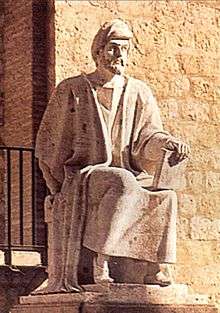
 In the Ottoman Empire, Muhammad's numerous descendants formed a kind of nobility with the privilege of carrying green turbans.
In the Ottoman Empire, Muhammad's numerous descendants formed a kind of nobility with the privilege of carrying green turbans.- A Georgian Muslim Imam from Tbilisi wearing a Turban.
 Al-Sayyed Ali al-Sistani, the spiritual leader of Many of Shia Muslims wearing a black turban.
Al-Sayyed Ali al-Sistani, the spiritual leader of Many of Shia Muslims wearing a black turban.
Judaism

The priestly mitre or turban (Hebrew mitznefet מִצְנֶפֶת) was the head covering worn by the Jewish High Priest when he served in the Tabernacle and the Temple in Jerusalem.
The Hebrew word mitznefet (מִצְנֶפֶת) has been translated as "mitre" (KJV) or "headdress". It was most likely a "turban", as the word comes from the root "to wrap".
In the Hebrew Bible, the turban worn by the High Priest was much larger than the head coverings of the priests and wound so that it formed a broad, flat-topped turban, resembling the blossom of a flower. The head covering of the priests was different, being wound so that it formed a cone-shaped turban, called a migbahat.
The priestly crown (Hebrew tzitz צִיץ "blossom" "flower") was attached to the turban by means of two sets of blue cords: one going over the top of the head and the other around the sides of the head at the level of the ears (Exodus 39:31).
According to the Talmud, the wearing of the turban atoned for the sin of haughtiness on the part of the Children of Israel (B. Zevachim 88b).
The Jews who lived under Arab rule during the Middle Ages, notably in Islamic Spain wore turbans and headwear not too different from their Muslim counterparts.
Rastafari
Members of the Bobo Shanti mansion of the Rastafari movement keep their hair and beards, mainly keeping their hair in dreadlocks, they have been wearing turbans over their dreadlocks protecting and keeping their dreadlocks clean, along with wearing robes since their founding in the 1950s,[18] being a small population it makes them more distinctive in appearance in Jamaica and elsewhere.[19]
Sikhism

The Sikh turban, known as the Dastar or a Dumalla or a "Pagg" cultural name, the turban is used to show others that they represent the embodiment of Sikh teachings, the love of the Guru and dogma to do good deeds,[20] the turban also protects Sikh's long unshorn hair and keep hair clean. The turban is mandatory for all members of Khalsa (Initiated Sikhs) to wear. The Rajastani turban is also commonly called the pagari (in the West, many Sikhs who wear pagri are sometimes mistaken for Muslims or Arabs.[21]).
All Sikh Gurus since Guru Nanak have worn turbans. However, covering one's hair with a turban was made an official policy by Guru Gobind Singh, the tenth Guru of the Sikhs. The main reasons to wear turban are to take care of the hair, promote equality, and preserve the Sikh identity. Sikh women may wear a turban if they wish.
.jpg)
Sikhs do not cut their hair, as a religious observance. The turban protects the hair and keeps it clean. As Sikhs only form 2% of India's population, their turbans help identify them. When he institutionalized the turban as a part of the Sikh identity, Guru Gobind Singh said, "My Sikh will be recognized among millions."
Turbans were formerly associated with the upper class, and many men in the cultural elite still wear turbans. This distinction between the turban-wearing upper class (Sardars) and commoners promoted segregation and elitism. In order to eliminate the class system associated with turbans, Guru Gobind Singh Ji declared each and every Sikh a Sardar. He also rejected the caste system by giving all Sikhs the last names Singh (Lion) or Kaur (Princess).
Modern Sikh men mainly wear four kinds of Turban. Morni Turban, Patiala Shahi Turban, Vattan Wali Turban and Amritsar Shahi Turban. The Dumalla style is more traditional and can be recognized by its horizontal wraps, versus the peaked wraps as seen in the aforementioned styles. The Dumalla is becoming more popular among Sikh youth (men and women).
The Dastar Bunga is the style of turban generally worn by Akali Singhs in battle. The "Chand Tora" is a metal symbol consisting of a crescent and a double edged sword, held in place at the front of the turban by a woven chainmail cord tied in a pattern within the turban to protect the head from slashing weapons. The purpose of the Tora is to keep the dastaar together. It goes over the bunga (inner turban) to protect it. It is also used for keeping shastars (small weapons) in place.
The most common turban colors worn by Sikhs are blue, white and black, although other colors are very popular as well. Orange and yellow are particularly prestigious and tend to be worn on religious events such as Vaisakhi. Meanings of the turbans are that the white turban means a saintly person leading an exemplary life. The blue turban signifies a mind a broad as the sky with no place for prejudice. The black turban is a reminder of the British persecution of the Sikhs in 1919, and represents humility. The orange turban is representative of courage, and wisdom. Royal blue is usually worn who are those who are learned the Sikh religion. Akali Nihang Sikhs decorate their turbans or Dumalla by wearing small weapons known as shastars in them. The turban's color may reflect association with a particular group of Sikhs, although none of the popular turban colors are exclusive to any particular group. Turban colors are generally a matter of personal choice in Sikhism, with many Sikh men choosing colors based on fashion or taste, sometimes to match clothes. There are traditions associated with some colours, for instance orange and black are often worn at political protest rallies whilst red and pink turbans are worn at weddings and other celebratory events.[22][23][24][25]
References
- ↑ "Turbans Facts, information, pictures | Encyclopedia.com articles about Turbans". www.encyclopedia.com. Retrieved 2016-04-19.
- ↑ "Do Sikh women have to wear a Turban (Dastaar) as well as men? | Sikh Answers". www.sikhanswers.com. Retrieved 2016-04-19.
- 1 2 Haddad, Sh. G. F. "The turban tradition in Islam". Living Islam. Retrieved 5 August 2013.
- ↑ "History and information on turbans". Retrieved 2016-12-03.
- ↑ "Alternative Wig Idea: Cover Hair Loss With a Cute Cap Instead". About.com Health. Retrieved 2016-04-19.
- ↑ Ovid, Metamophoses, 11.146, http://www.perseus.tufts.edu/hopper/text?doc=Perseus%3Atext%3A1999.02.0028%3Abook%3D11%3Acard%3D146
- ↑ Norma Goldman, "Latin Via Ovid: A First Course" p. 160 https://books.google.com/books?id=fORWW12AoTAC&pg=PA158&lpg=PA158&dq=ovid+turban+midas&source=bl&ots=1jKDWjz-aa&sig=hoOBC5Uwef1nYPE68mBgNT0yWQk&hl=en&sa=X&ei=RPtGVLPDMYGMyASnjIH4Bg&ved=0CFUQ6AEwBw#v=onepage&q=ovid%20turban%20midas&f=false
- ↑ Raffaele D'Amato "Roman Military Clothing (3): AD 400-640" p. 4, https://books.google.com/books?id=q0J78geiNrYC&pg=PA4&dq=phakeolis+turban&hl=en&sa=X&ei=ePlGVMeXOs_9yQSo7ILACg&ved=0CB8Q6AEwAA#v=onepage&q=phakeolis%20turban&f=false
- ↑ The Greenwood Encyclopedia of Clothing through World History, p. 269, https://books.google.com/books?id=q6FI2czFz6MC&pg=PA269&dq=phakeolis+turban&hl=en&sa=X&ei=ePlGVMeXOs_9yQSo7ILACg&ved=0CCoQ6AEwAg#v=onepage&q=phakeolis%20turban&f=false
- ↑ Hughes, Thomas Patrick. A Dictionary of Islam: Being a Cyclopedia of the Doctrines, Rites, Ceremonies and Customs Together with the Technical and Theological Terms of the Muhammadan Religion. WH Allen & Company, 1895.
- ↑ Me, Rondo B. B. (2004). Fiji Masi: An Ancient Art in the New Millennium. Burleigh Heads: Catherine Spicer and Rondo B.B. Me. p. 40. ISBN 978-0-646-43762-0.
- ↑ Cochrane, Susan; Quanchi, Max, eds. (2014). Hunting the Collectors: Pacific Collections in Australian Museums, Art Galleries and Archives. Cambridge: Cambridge Scholars Publishing. p. 58. ISBN 978-1-4438-7100-6.
- ↑ Rubin, Alyssa J. (15 October 2011). "Afghan Symbol of Identity Is Subject to Search". New York Times. Retrieved 16 October 2011.
- ↑ Inter Islam. "The turban, topee and kurta - in the light of Ahadith and the practice of our pious predecessors". inter-islam.org. Retrieved 2014-02-10.
- ↑ http://www.shafifiqh.com/2011/07/03/wearing-a-turban/
- ↑ "Islamic Dress and Head-dress for men". sunnah.org. Retrieved 2014-02-10.
- ↑ "SeekersGuidance - Can Anyone Wear a Turban? Are There Styles Specific for Scholars? – Answers". seekersguidance.org. Retrieved 2014-02-10.
- ↑ ROOTS RASTA RUNWAY
- ↑ "BBC - Religions - Rastafari: Bobo Shanti".
- ↑ Sidhu, Dawinder (2009). Civil Rights in Wartime: The Post-9/11 Sikh Experience. Ashgate Publishing, Ltd. p. 48. ISBN 9781409496915.
- ↑ Hoang, Lien. "Mistaken for Muslims, Sikhs hit by hate crimes" "msnbc.com", May 8, 2011
- ↑ "design: The Orange Turban And Their Importance". testa0.blogspot.ca. Retrieved 2016-03-04.
- ↑ "Why Do Sikhs Wear Turbans?". About.com Religion & Spirituality. Retrieved 2016-03-04.
- ↑ "Significance of color/colour of turban/pug/pag/dastaar/pagri/pagree in Sikhism". www.sikhwomen.com. Retrieved 2016-03-04.
- ↑ "Why are turbans of different colours? - Quora". www.quora.com. Retrieved 2016-07-18.
See also
External links
| Wikimedia Commons has media related to Turbans. |
- Why Sikhs wear a turban
- Sikh Fortress Turban
- Tutorial on how to make a Turban (Pagri)
- Information on why Sikhs wear Turbans
- Understanding Turbans
